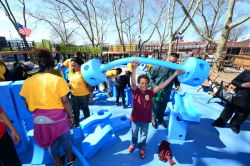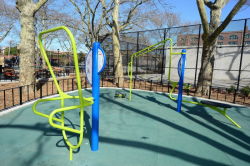Betsy Head Park
Betsy Head Park
What was here before?
In the early 1900s, Brownsville was a densely-populated neighborhood with an estimated population of 25,000. Many lived in severely overcrowded tenements with very little open space. Brooklyn, in general, had very few playgrounds with only eight in the entire borough by 1913.
How did this site become a park?
The land for Betsy Head Park was acquired in 1913 through condemnation and paid for by the property owners of Brownsville at a cost of $250,000. The playground facilities were commissioned with the funds bequeathed by philanthropist, Betsy Head.
Architect Henry B. Herts designed the new playground, which was built in 1915 by the Public Recreation Commission and turned over to NYC Parks later that year. The park included a rest pavilion, wading pool, playground, school farm garden, bath building, field house, running track, tennis courts, and the city’s first outdoor public swimming pool It was one of the most complete and popular facilities of its time, embodying all the ideas current in recreation.
In 1936, the park was redesigned extensively, and the Olympic-sized swimming pool was constructed. Architect John Matthews Hatton’s pool house exemplified the sleek Art Moderne style with liberal use of glass block and a parasol roof. One of eleven pools built by the Works Progress Administration during the summer of 1936, the pool is a relic of the New Deal era.
The construction project, organized by NYC Parks Commissioner Robert Moses (1888-1981), and funded by the federal Works Projects Administration (WPA), was part of a citywide effort to erect recreational facilities in under-served neighborhoods. The pools represented the forefront of design and technology. They attracted aspiring athletes and neighborhood children. The influence of the pools extended through entire communities, changing the way millions of New Yorkers spent their leisure time. Although damaged by fire soon after it opened, the pool was rebuilt in 1939.
In 2020, the Betsy Head Park was renovated under the Anchor Park Initiative. The work included an outdoor classroom with tiered seating, a large skate park, a parkour fitness area, accessible bank shot basketball along with a full-court basketball, and a four-lane recreational running track surrounds a new synthetic turf playing field. Abel Bainnson Butz, LLP reimagined a century-old park as a 21st-century paradise for the Brownsville community.
Who is this park named for?
This park is named for Betsy Head (1851-1907), a British immigrant who was a philanthropist and businesswoman, who left the City of New York a bequest of $190,000 to build recreational facilities. She stipulated in her will that half of her residual estate should be given to sixteen charities, many of which were dedicated to the welfare of children, and the other half should be donated to the City of New York for the “purchase and improvement of grounds for the purposes of health and recreation.”
Check out your park's Vital Signs
Clean & Safe
Green & Resilient
Empowered & Engaged Users
Share your feedback or learn more about how this park is part of a
Vital Park System









